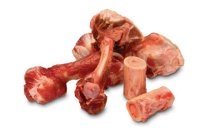| Back to Back Issues Page |
 |
|
Bully for You!: Raw Food Basics and More November 03, 2010 |
Bully For You!The Ezine for Pit Bull LoversNovember 2010 Volume 8Paws-i-tive Press What's New at The Proper Pit Bull Feature Article: Raw Food Basics by Lisa Smith Quote of the Month Paws-i-tive PressHere's a fun video from the Ukraine. Apparently this dog thinks the whole world is his agility course!What's New at The Proper Pit BullHelp with an abused foster dog Merle coat coloration Can toenails change color? How to tell an Amstaff from a pit bull Feature Article: Raw Food Basics Homemade dog food has become increasingly popular since the massive recalls in 2007 when thousands of pets died from eating contaminated commercial food. When done properly, the raw diet appears to be healthier than even the most high quality kibble. Every dog food on the market contains some form of grain. Dogs don't derive their energy from carbohydrates like we do; they use fat as fuel. Grains may contribute to allergies, skin problems, ear infections, and a malady of other health issues.
Homemade dog food has become increasingly popular since the massive recalls in 2007 when thousands of pets died from eating contaminated commercial food. When done properly, the raw diet appears to be healthier than even the most high quality kibble. Every dog food on the market contains some form of grain. Dogs don't derive their energy from carbohydrates like we do; they use fat as fuel. Grains may contribute to allergies, skin problems, ear infections, and a malady of other health issues. Unfortunately, veterinarians profit from treating these diseases and from prescribing expensive special diets that would not be needed if the animals had been fed properly from the start. "Rather than addressing what their patients are eating, far too many veterinarians put them on cortisone/prednisone to stop self-mutilation from scratching and chewing," explains Dr. Michael Fox. "These clear up once the dogs are taken off highly processed manufactured foods." Imagine what your dog's ancestors ate before Kibbles N' Bits was invented: the raw meat, bones, and digested stomach contents of prey animals. When preparing your dog's meal, use that "prey animal" as your model. Raw Meat: This group includes beef, poultry, lamb, rabbit, and whole raw eggs. You can feed it whole, in chunk form, or ground, as long as the quality of meat is fit for human consumption. Is it safe to feed your dog raw meat? Yes! Domestic dogs have the same short, acidic digestive tract that their wild cousins have. Dogs are notorious for snacking on old carcasses; bacteria is not a concern for pets with a strong immune system. Also worth noting: eating raw meat will not encourage your pet to kill other animals. Every animal's prey drive is inherent and instinctive. Your dog won't connect the chicken in her food dish with the neighbor's cat. Raw Bones: It is imperative that you only feed UNCOOKED bones! Cooked bones may splinter and cause choking or intestinal damage. However, chicken bones are soft enough to bend easily, and they break well for the dog to digest. Many people buy inexpensive neck bones from their local butcher, but you can also use packaged meat from the grocery store. Bones are a crucial part of the raw diet because calcium deficiency can lead to severe orthopedic problems. Meat and eggs are high in phosphorus but don't contain calcium; bones and egg shells contain calcium. When there is more phosphorus than calcium in the body, the body will use calcium stored in bones so it is imperative to feed a balanced diet that includes raw meaty bones. Raw Vegetables: Use a food processor, blender, or juicer to make fresh raw vegetables easier for your pet to digest. A combination of above ground vegetables (broccoli, kale, celery, squash) and below ground vegetables (carrots, yams, potatoes) should be fed daily. Some common changes reported by pet owners who have switched to a raw diet include:
Generally speaking, adult dogs should only be fed once a day. A typical meal for a 100-lb dog might be 2 lbs raw meat, 2 chicken necks, and 1/2 cup vegetables. Some people feed their dog a large chicken quarter (including bones) and the vegetables. The raw diet isn't an exact science and it leaves a lot of room for variety. However, you need to make sure that your pet is getting a balanced diet. So, while you can vary the meat, it's important to stick with the basic formula. There are lots of resources online, and there is also a great book by Kymythy R. Schultze called The Ultimate Diet - Natural Nutrition for Dogs and Cats. ******************************** Disclaimer: There is some evidence to suggest that humans with weak immune systems may be at greater risk for contracting zoonotic infections from dogs eating raw protein. Raw feeding may not be right for some dogs. The information contained in this article is not a substitute for advice from a qualified pet care professional. Before changing your dog's diet, consult your veterinarian. ******************************** Would you like to share your experience with feeding raw or ask a question about it? Add your comments to the raw food diet discussion page at The Proper Pit Bull website. What NOT to Feed Your Dog
Quote of the Month~Anne Tyler~
|
| Back to Back Issues Page |